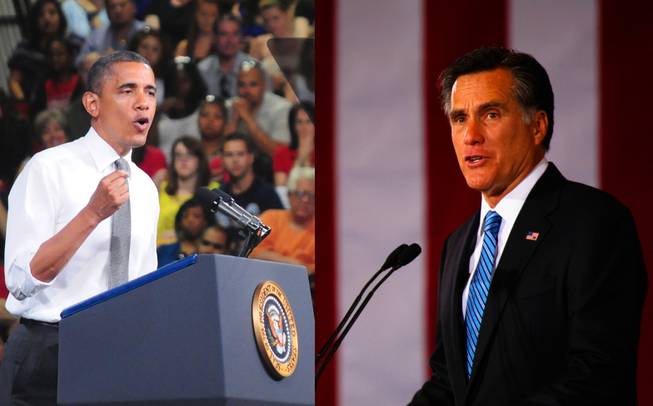
President Barack Obama and GOP challenger Mitt Romney
Thursday, Sept. 27, 2012 | 2 a.m.
Take one look at the screwy results from three public polls in the presidential race in Nevada this week and one might wonder why anyone bothers conducting horse race surveys in the Silver State at all.
The three released Monday showed three dramatically different results in the tight race between President Barack Obama and Republican rival Mitt Romney in the battleground that is Nevada. The results in the neck-and-neck U.S. Senate race between Republican Dean Heller and Democrat Shelley Berkley weren’t any better.
Depending on which survey you look at, Obama and Romney are tied, or Obama has a 9-point lead. In the Senate race, either Berkley is screaming along with a 4-point lead or Heller has it wrapped up with a 5-point advantage.
The wild results are reminiscent of a slew of public polls in the U.S. Senate race from two years ago — surveys that consistently indicated Republican Sharron Angle would trounce Sen. Harry Reid on Election Day. Of course, the opposite happened.
Part of the problem with the different results among the polls released by the Nevada Retail Association, Public Policy Polling and the American Research Group is simply statistics. Polls have margins of error that can swing the results as much as 8 or 9 points.
But Nevada is also a quirky place to try to get an accurate survey. Here’s a look at five variables that make the Silver State so difficult to gauge.
-
The margin of error plays an outsized role when it’s a close race
First, a quick statistics lesson.
Polls are simply an estimate of where the electorate is at a single moment in time. Because polls are an estimate, there is natural error. Most public polls have about a 4-point margin of error. That means 95 percent of the time, any single poll will return a result that is within an 8-point range of the true picture.
This is particularly important to understand in a race as tight as the presidential and U.S. Senate races are in Nevada. So, when a poll comes back, as the Retailers’ did with Obama and Romney each at 46 percent, they could be as far away as Obama with 50 percent and Romney at 42 percent or vice versa.
-
Figuring out who will actually vote: not such an easy task
Putting the margin of error aside, a poll won’t be worth much if the sample doesn’t reflect who will actually be voting in the general election. Putting together a sample that reflects the electorate is just as much art as it is science.
Not only does a pollster have to put together a sample of voters that breaks correctly along partisan lines but one that also reflects the same gender, age and racial make-up of the electorate.
But the challenge doesn’t stop just at demographics. Pollsters have to find the actual voters who will cast a ballot.
That can take some digging. Instead of simply asking the person who answers the phone whether they plan to vote — the answer is almost invariably yes — pollsters can have better results by calling those with a demonstrated history of voting.
That digging is expensive. Public polls are usually not expensive.
-
Nevada voters are notoriously difficult to get ahold of
This, again, is a variable that adds to the expense of a good poll — actually reaching those voters who have been identified as those who will turn up in November.
As veteran pollster Mark Mellman — the only one to correctly gauge the Reid-Angle race — told the Las Vegas Sun two years ago, it can take up to six or seven phone calls to reach voters. If the effort isn’t made, a pollster is simply surveying people who answer their phones on the first ring — hardly a representative sample.
And in Nevada, home to a sizable population of shift workers, voters aren’t necessarily home during the most popular poll-calling hours of 5-9 p.m.
-
Nevada is a pretty diverse place
As one political operative interviewed for this story said, it’s easier to poll a racially and socio-economically homogenous population — say a big square state in the middle of the country — than it is one with strong ethnic diversity.
Nevada is about 27 percent Hispanic, 9 percent black and 8 percent Asian. The electorate doesn’t necessarily break down according to the same proportions. In 2010, for example, Hispanics made up 16 percent of those who turned out to the polls — a number higher than many anticipated due to Democrats’ extensive turnout efforts among that population.
Pollsters also can run into language barriers with Hispanic and Asian voters.
-
Nevada is a pretty independent place
Nonpartisan voters make up about 17 percent of registered voters. In fact, nonpartisans are registering at a faster clip than Republicans, despite the party’s expensive voter registration effort. In 2010, those who identified themselves as “independent” made up 32 percent of the voting electorate, according to exit polls.
That comparison — 17 percent of registered voters vs. 32 percent of actual voters — shows that many voters actually think of themselves as independent, even though they are registered as either Republican or Democrat.
A pollster who bases his sample on respondents who “self-identify” as independent — a common trend as disgust with the parties intensifies — will likely have a skewed sample.

Join the Discussion:
Check this out for a full explanation of our conversion to the LiveFyre commenting system and instructions on how to sign up for an account.
Full comments policy